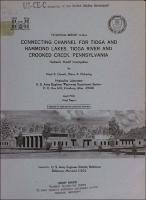Please use this identifier to cite or link to this item:
https://hdl.handle.net/11681/13541Full metadata record
| DC Field | Value | Language |
|---|---|---|
| dc.contributor | United States. Army. Corps of Engineers. Baltimore District | - |
| dc.contributor.author | Oswalt, Noel R. | - |
| dc.contributor.author | Pickering, Glenn A. | - |
| dc.date.accessioned | 2016-08-18T19:13:50Z | - |
| dc.date.available | 2016-08-18T19:13:50Z | - |
| dc.date.issued | 1976-04 | - |
| dc.identifier.uri | http://hdl.handle.net/11681/13541 | - |
| dc.description | Technical Report | - |
| dc.description | Abstract: A channel will be excavated to connect the west side of Tioga Lake with the east side of Hammond Lake to permit the two reservoirs to be operated as one flood-control project. An overflow structure will be used to keep the drainage in Tioga Lake from entering Hammond Lake until storage in Tioga Lake exceeds the weir crest el 1101 ft msl. Normal flows from Hammond Lake to Tioga Lake will be controlled by an outlet works in the structure, and flood flows in this direction will pass over the weir. The model investigation was concerned with the adequacy of the connecting channel and its associated structure. The study was conducted in a 1:80-scale model which reproduced a portion of the Tioga and Hammond reservoirs, the connecting channel including a plunge pool, weir, and outlet works, and the Tioga Lake outlet works in the structure. Concerning flow from Tioga Lake to Hammond Lake, the efficiency of the uncontrolled weir was less than originally anticipated. The plunge pool as originally designed resulted in satisfactory flow conditions for all expected discharges. However, tests were conducted with the baffle blocks and end sill removed and the elevation of the apron raised in an effort to effect a cost reduction. These basins a lso resulted in satisfactory performance. Because the rock to be excavated from the plunge pool was needed for bank protection in other areas of the project, the apron of the recommended plunge pool was retained at the original elevation and the baffle blocks and end sill were removed. Velocities and current patterns measured at the Hammond end of the connecting channel indicated the proposed 12-in. riprap on the slopes would be stable for all expected flows. The model indicated that the uncontrolled weir was more efficient than expected for flow from Hammond Lake to Tioga Lake. Flow conditions were satisfactory for both uncontrolled weir flow and for flows through the outlet works stilling basin. The model weir and stilling basin were removed from the connecting channel, and rating curves were obtained for flow in each di rection through the connecting channel. | - |
| dc.publisher | Hydraulics Laboratory (U.S.) | - |
| dc.publisher | Engineer Research and Development Center (U.S.) | - |
| dc.relation | http://acwc.sdp.sirsi.net/client/en_US/search/asset/1033883 | - |
| dc.relation.ispartofseries | Technical report (U.S. Army Engineer Waterways Experiment Station) ; H-76-6. | - |
| dc.rights | Approved for public release; distribution is unlimited. | - |
| dc.source | This Digital Resource was created from scans of the Print Resource | - |
| dc.subject | Channels | - |
| dc.subject | Waterways | - |
| dc.subject | Outlet works | - |
| dc.subject | Hammond Lake | - |
| dc.subject | Tioga Lake | - |
| dc.subject | Hydraulic models | - |
| dc.subject | Weirs | - |
| dc.subject | Open channel flow | - |
| dc.subject | Pennsylvania | - |
| dc.title | Connecting channel for Tioga and Hammond Lakes, Tioga River and Crooked Creek, Pennsylvania : hydraulic model investigation | - |
| dc.type | Report | en_US |
| Appears in Collections: | Technical Report | |
Files in This Item:
| File | Description | Size | Format | |
|---|---|---|---|---|
| TR-HL-76-6.pdf | 4.03 MB | Adobe PDF |  View/Open |